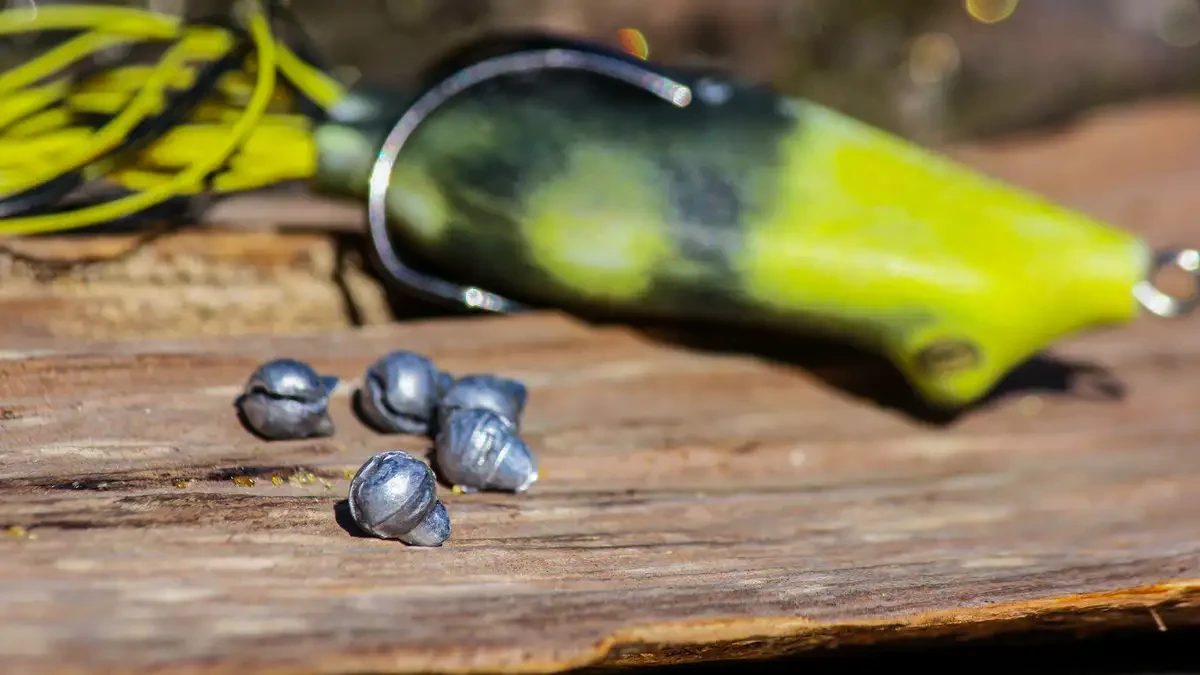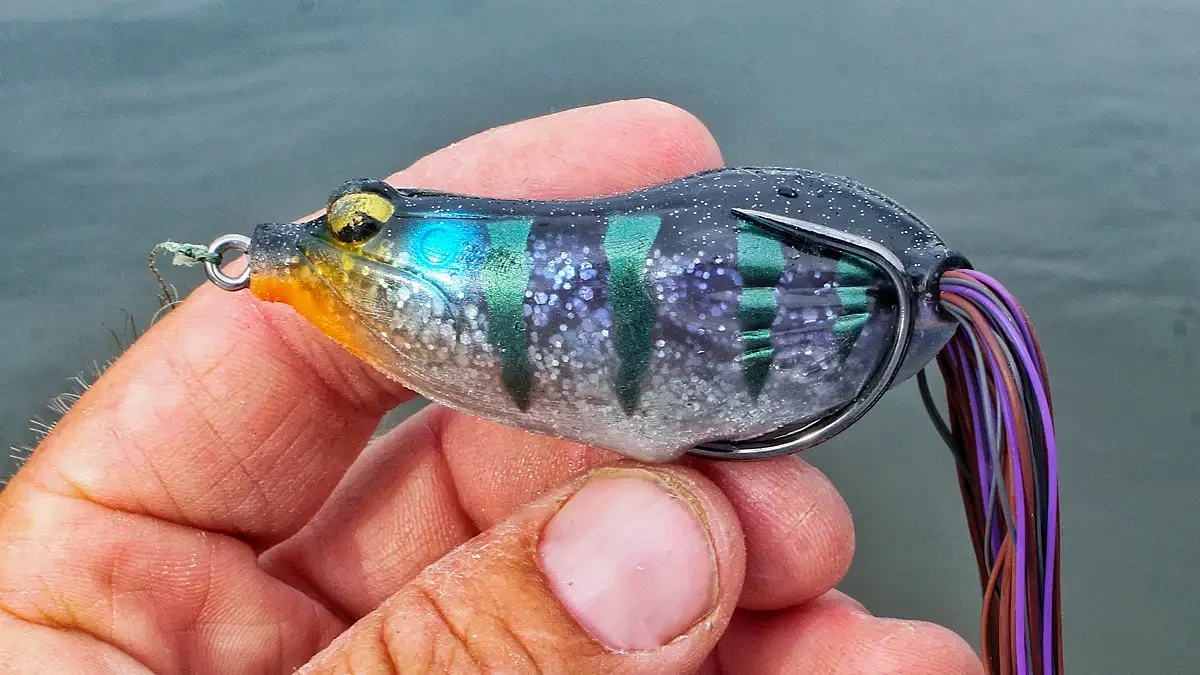Hollow body frogs are some of the most tweak-able and customizable baits of all the bass fishing genres of lures out there. You can trim the skirts, bend the hooks, add trailer hooks, weights, rattles and the list goes on. Man you can even boil these baits if you feel so inclined. All of these frog tweaks can make for better bass fishing.
We’ll look at the common modifications that most anglers do to these hollow body topwater baits and perhaps give a few more of lesser known hacks to increase your bites and hookups. Because at the end of the day we want to get your bites but also land them.
Two most common of the best frog tweaks
Most anglers who have fished a frog for a while will know these, but here’s a refresher for some and perhaps a good tip or two for those just getting into frog fishing. First thing’s first, you’ll want to bend the hooks up a bit on almost every hollow body frog out there. Frogs are designed to come across and through very dense cover.
To make them weedless, most frogs have their hook points running parallel and tight to the backs of the baits. This snag resistant feature unfortunately makes hooking a fish a little difficult at times too. To fix this, anglers can bend the hook points up just a little, to where they have a better chance to catch a bass’ lip when the fish chomps down on the bait.
To do this, hold the shaft of the hook in one hand and take hold of the bend of the hook (one at a time) with a pair of needle nose pliers. Gently flex the hook out, until the hook point has a slight upward angle as compared to the back of the bait. Do this on both sides, making every effort to bend them evenly. But whatever you do, don’t go to far here as it can weaken the integrity of the hook and cause it to bend out on a big fish.
The other common frog tweak is to trim the rubber legs that stick out of the tail end of the bait. These legs look really tantalizing in the water as they sway back and forth. But they can be a distraction from the body of the bait where the hook is. Finicky bass have a tendency to pull a frog down by its legs, never getting the business end of the bait in their mouths. You can eliminate some of this by trimming the legs. Shortening one side more than the other used to help the baits walk a little better, but this isn’t really that beneficial with modern frogs as almost all are fairly easy to walk right out of the pack.

Best mat fishing frog tweaks
A little added noise can be a good thing when fishing a hollow body frog, especially around and over thick cover where it’s hard for a bass to locate a bait with its eyes alone. When open water frogging, bass can visually track down a quiet bait by either seeing the lure itself or being alerted to the disturbance on the top of the water created by the bait. But a bass buried up under a mat, for instance, may need a little help.
Inserting small glass rattles into a frog is a great way to create a little commotion. Some hollow body frogs actually come with rattles already in the baits. But you can add cylindrical glass rattles to frogs fairly easily by inserting them into the hook hole. Lake Guntersville native and frog fishing fanatic Alex Davis even buys tiny jingle bells to insert in his frogs, giving his baits a unique sound when trying to pull heavily pressured largemouth bass up and through the thick mats of his home lake.
There’s another way to up your odds when fishing a frog over matted vegetation. I actually learned this one first hand from MLF Pro Randal Tharp during a fishing trip on Guntersville many years ago.
I was throwing my little frog right alongside Tharp, and he was getting a dozen bites to my one. Out of frustration, I finally asked him what was up. He told me to set my frog on the water by the boat. I obliged. He sat his beside mine (that was floating on the surface), and his sank like a rock. I looked at him quite confused and he grinned as he pulled a handful of splitshot out of his pocket.
Frog experts like Tharp learned long ago that adding weight to a frog allows the bait to make a better impression on the scummy surface of a mat. As I looked around in that moment, you could see lines where dozens of his casts had been, and you could barely tell where I had thrown. The bass never had a chance to target my bait because they couldn’t even see it.
You can add weight to your frog by rolling it over and inserting the weights into the hole where the hook exits the bait. BBs, split shots and even tiny tungsten bullet weights work well. But when adding rattles and weights, keep in mind the body of the bait will need to be able to collapse to hook a fish, so don’t go overboard.
Best replacement tweaks for frogs
You can actually change the hook of a hollow body frog, if you feel the need. Most hollow body baits come with quality hooks these days. And if one doesn’t have a good hook, there’s another one out there that does. Still, in an effort to have an exhaustive library of content to meet every angler’s needs, we actually did a feature a little while back on how to change out a frog hook. You can read that here.
Another (likely unnecessary most of the time) way to get new life out of an old frog is to replace the frog legs. I have actually done this before, admittedly more for sentimental reasons and a confidence boost than anything. The legs wore out on one of my favorite old frogs that has gotten a lot of big bites for me over the years.
So, I took a jig skirt and tied a short piece of heavy-pound-test mono around it about a third of the way down. I then fed the tag end of my line through the leg holes (after having completely removed the old material) and pulled the doubled over skirt material through the holes until the shorter end of the skirt popped through the second hole. Then I evened the legs out and added a little super glue to each side to secure it. And voila, new legs.

Two more tips and final thoughts
You can add a Lake Fork Frog Tail Hook to the back of your hollow body bait too, by simply slipping the eyes of the hook over each of the frog’s hook points. This fixes the hook point in an upward position to help keep the bait as weedless as possible, but also helps a lot with short striking bass that just grab the legs of the bait.
Some anglers boil their hollow body frogs as well, to create a softer bait that will compress better when bit. This is done to improve the hookup ratio, but is likely an outdated hack as there are a lot of quality frogs on the market now made from fantastic materials that are flexible but still durable.
As we said at the onset, there are a lot of little tweaks you can do to a hollow body bait, and these aren’t even all of them. But this list does include the more important ones. You want to make sure your hook is poised and ready when a bite comes, bending it up if necessary.
Almost all frog legs can be shortened at least a bit, decreasing their length more and more the thicker the cover. And adding rattles and a little weight can make for much more effective mat fishing. The others are fun to play around with and will help you get a little more life and a few more fish catches out of your frogs. Nothing wrong with either of the those outcomes, so feel free to tinker away.














